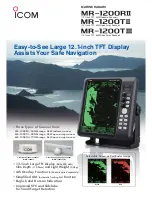
address those very directions that will help create a highly accurate and statistically viable
result from the Patch Test.
11.6
Basic data collection criteria
Patch test data collection does not have to be in any set order, but the order that the values
are computed, in the data collection or processing software, will be in a distinct order.
Normally, Latency is the first value that is computed, followed by Roll, Pitch and Yaw (or
heading). The solving order is important, as will be seen below.
11.7
Patch Test data collection error areas
There are many common errors, or mistakes, made during the patch test data collection.
11.7.1
Positioning
The accuracy of the positioning system is a common area where errors arise. DGPS has, at best,
a variability of ± 0.50 metres, whereas RTK variability is ±0.05metres.
A recent article, by Mike Brissette, (MosaicHydro LTD, Canada) in
Hydro International
(‘Stop
Using DGPS’; Hydro International; Volume 16, Issue 7; Oct 2012) documents this issue very well:
http://www.mosaichydro.com/papers/M%20Brissette%20-%20Stop%20Using%20DGPS.pdf
The article fully details the errors that can occur by using DGPS, instead of highly accurate
positioning for the Patch Test data collection. The error increases inversely with the water
depth,
i.e. the shallower the water, the larger the error that can be induced by using DGPS over more
accurate positioning.
However, many users do not have any better positioning capabilities than DGPS; how can they
still obtain valid patch test results without having centimetric accurate positioning? This is, in
large part, what this paper is concerned with. However, even with centimetric position, the
following should be followed.
11.7.2
Feature chosen for test
Where at all possible, for latency, pitch and heading data collection, a feature should be used
rather than a slope. Slopes tend to be too variable as opposed to a well-defined feature such as
a wreck, rock outcrop or pipeline.
One of the other issues, with using a slope, is that many times the shallow end of the slope
does not allow sufficient area or depth for the vessel to come about and line up for the
reciprocal run; this does not allow sufficient time for the motion sensor to settle down nor for
the helmsman to find a steady course.
It has been found that when using a slope, for the pitch calibration, that the heading angular
offset can have a large influence. If the sonar head does not track exactly the same route, up
and down the slope, the heading offset will affect the pitch angular result.
Page
137
of
210
Version
5.0
Rev
r002
Date
05-08-2014
Summary of Contents for 2022
Page 2: ...Page 2 of 210 Version 5 0 Rev r002 Date 05 08 2014 Part No 96000001 ...
Page 4: ...Page 4 of 210 Version 5 0 Rev r002 Date 05 08 2014 Part No 96000001 ...
Page 37: ...Figure 26 Projector cable configuration Page 37 of 210 Version 5 0 Rev r002 Date 05 08 2014 ...
Page 68: ...Page 68 of 210 Version 5 0 Rev r002 Date 05 08 2014 Part No 96000001 ...
Page 86: ...Page 86 of 210 Version 5 0 Rev r002 Date 05 08 2014 Part No 96000001 ...
Page 90: ...Page 90 of 210 Version 5 0 Rev r002 Date 05 08 2014 Part No 96000001 ...
Page 92: ...Page 92 of 210 Version 5 0 Rev r002 Date 05 08 2014 Part No 96000001 ...
Page 100: ...Page 100 of 210 Version 5 0 Rev r002 Date 05 08 2014 Part No 96000001 ...
Page 104: ...Page 104 of 210 Version 5 0 Rev r002 Date 05 08 2014 Part No 96000001 ...
Page 126: ...Figure 127 Smooth log information copied from real time survey log ...
Page 150: ...Page 150 of 210 Version 5 0 Rev r002 Date 05 08 2014 Part No 96000001 ...
Page 164: ...Page 164 of 210 Version 5 0 Rev r002 Date 05 08 2014 Part No 96000001 ...
Page 196: ...Page 196 of 210 Version 5 0 Rev r002 Date 05 08 2014 Part No 96000001 ...
Page 199: ...Figure 169 Sonic 2024 Receive Module Page 199 of 210 Version 5 0 Rev r002 Date 05 08 2014 ...
Page 207: ...Figure 177 SIM Stack Outline Page 207 of 210 Version 5 0 Rev r002 Date 05 08 2014 ...
Page 209: ...Figure 179 I2NS IMU Dimensions Page 209 of 210 Version 5 0 Rev r002 Date 05 08 2014 ...
















































